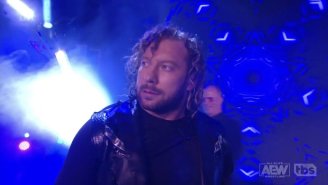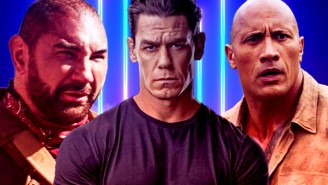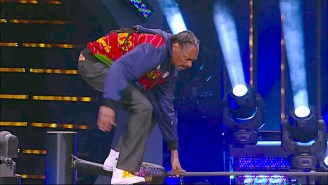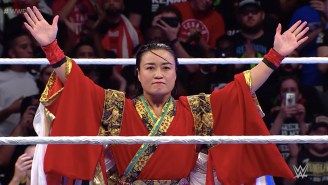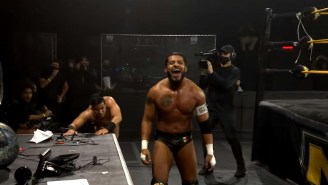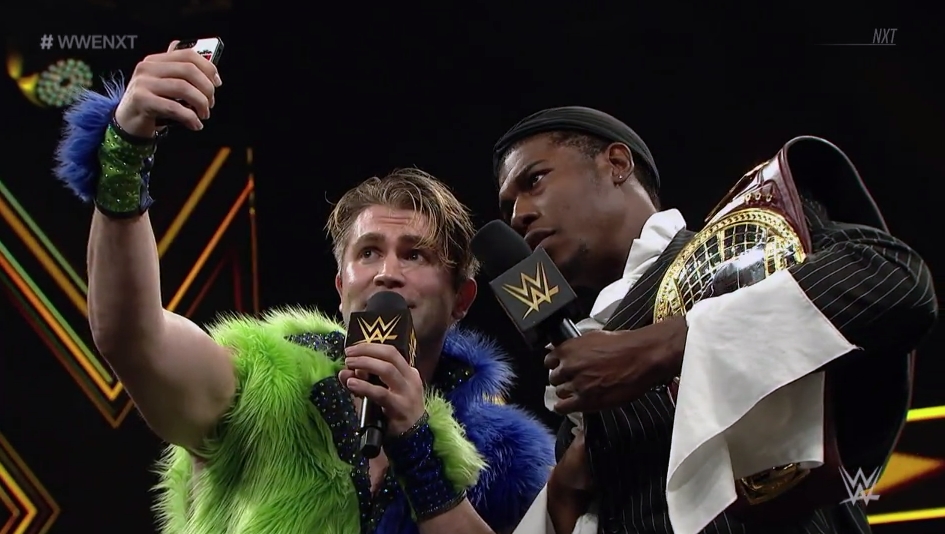
Previously on the Best and Worst of NXT: The Viking Raiders (if that is their real name) tried to relinquish the NXT Tag Team Championship, got goaded into a championship match, and then when the match ended via disqualification, relinquished them anyway.
If you missed this episode, you can watch it here.
If you’d like to read previous installments of the Best and Worst of NXT, click right here. Follow With Spandex on Twitter and Facebook. You can also follow me on Twitter, where everything and everyone is terrible.
And now, the Best and Worst of WWE NXT for May 22, 2019.
Best: What Is This, A Crossover Episode?
In this essay, I plan to argue that the NXT is not only the “true” WWE Universe, but that NXT TV rivals any television show or series of novels attempting an expansive, detailed, and immersive fictional universe over the past seven years. With Game of Thrones just ending and so many of the conversations revolving around how hard it is to “please everyone” and remain consistent with your characters, their histories, and their motivations, I would argue that NXT has accomplished everything George R.R. Martin hoped to with A Song Of Ice And Fire, only as a weekly hour-long pro wrestling show that does like 50 episodes and 5 double-feature-length live specials every year without taking a break.
NXT stars have gone up to the main roster and come back for guest spots in the past, but I believe the return of the Tyler Breeze character is first “true” return, and establishment that the main roster exists as a Great Unexplained. Only the top warriors are gifted with the opportunity to explore it, as it exists as a sort of free-form manifestation of extremes. The travelers who brave it are only manipulated and corrupted and torn apart by it, gaining enough power to remain or slowly dissipating until they’ve lost everything that makes them special, and only the most brave, tested, and legendary can return from it to tell about it. Nobody really knows what it’s supposed to mean.
Think of it this way; NXT is the peak battleground, our ultimate understanding of the art in its pure form. It was the dream of Dusty Rhodes, the Galileo, and Dusty valued story and connection above all else. My hand, is touching your hand. NXT is his final story for us: an endless, complex narrative about the industry that goes on, so that even though Dusty’s gone, he’s still here with us, leading us through it step-by-step. It’s Dusty’s critique on the idea of the main roster and where pro wrestling goes if it’s truly homogenized and has its colors greyed so it can be scooped apathetically into as many bowls as possible. That main roster is an attempt to spread a finite amount of art over a broader surface, the world — the entire world — and it dissipates and breaks apart because it was never meant for that. It’s why WWE rarely makes sense, and why the characters seem to reboot and reset on every cycle, eschewing their histories and personalities in pursuit of the largest portions of the greyest meal.
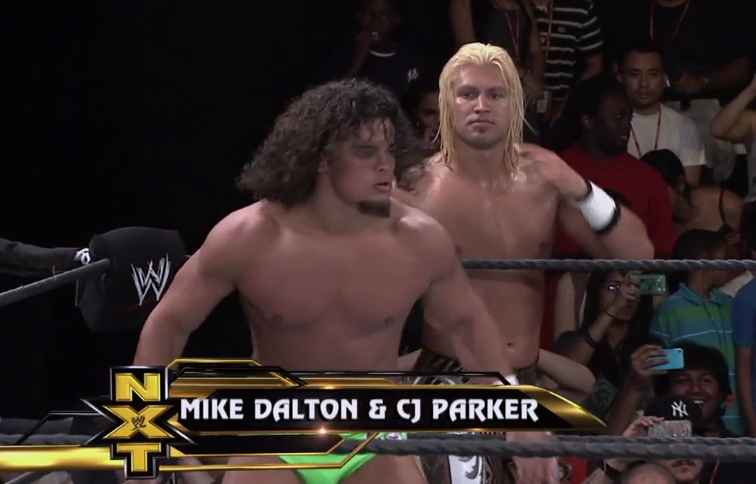
Tyler Breeze is an NXT Original. It’s an interesting concept. He was on the very first episode of the Full Sail era, and the Tyler Breeze character came at the perfect moment. Sami Zayn had just happened and brought new eyes to the show on Hulu, along with Cesaro. It was the convergence of the hope and dream of independent wrestling — where you can make it if you’re just good enough and can just try hard enough — with the jaded, resigned expectations of the “main roster.” “Mike Dalton” watched and learned and turned himself into a ridiculous male model character, a selfie-obsessed Zoolander with a cool entrance that got a “that was awesome” chant before he could even start wrestling. It was the first successful “homegrown” character of a new era. An example that if you’re good enough and try hard enough, you can make it. At least on this little landing the American Dream created for the magical bullshit of pro wrestling on the precipice between empty, worldwide stardom and oblivion. WWE removed as much of the foundation as it could by absorbing and destroying everyone, and then made its own Heaven an unbearable place to spend your life.
We knew Breeze wouldn’t “succeed” on the main roster, because the character is NXT. He was made in front of our eyes. We saw the work that went into it. We saw him grow and learn. We saw his sequence in the fatal four-way for the NXT Championship. We saw him wrestle Liger. We saw him enter with a bunch of ladies dressed like New York landmarks. Breeze the performer left to ply his trade in the Great Unexplained and made something of a mark, but Breeze the character never left. The performer simply removed the skin. It was there waiting for him when he returned.
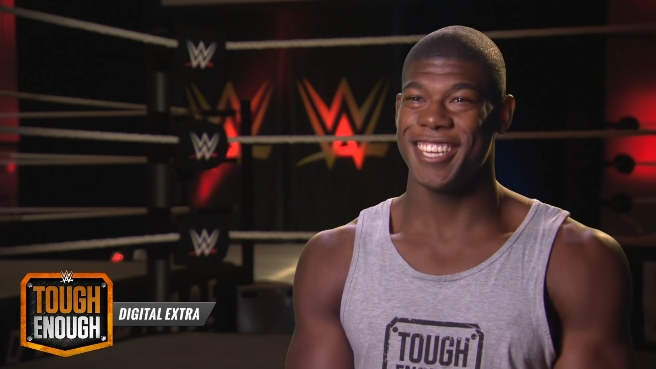
While he was gone, the most concentrated form of that “magical bullshit” — the only way to describe pro wrestling’s unique tendency to appeal to you by doing the most base and dumb thing you could imagine, because it speaks to a part of your brain your conscious mind sometimes doesn’t — became Velveteen Dream. It was the same story. A jobber nobody really paid much attention to looks around him, sees what works, and emerges from a creative cocoon as a fully-formed character. Dream was made in front of our eyes. We saw the work that went into it. We saw him grow and learn. We saw him feud with Aleister Black over whether or not a dude will say his name, and make it something unforgettable, right out of the gate. We saw him enter with a bunch of dudes while he was dressed as a New York landmark.
NXT is unique in that it allows WWE to tell the beginning, middle, and, in a way, end of a Superstar’s story. There are exceptions, especially lately, but an important NXT character usually doesn’t leave without some sort of conclusion to their narrative. Usually it’s a lot like the end of Return of the King, where we tearfully watch them board a boat to some place we don’t understand, where they’ll spend the rest of their days, for better or worse. We wish them the best, and selfishly wish they could just stay. Tyler Breeze, incredibly, is the first NXT “original” to truly take that voyage, end his story, and then return to add another chapter. Not as “WWE Superstar Tyler Breeze,” but as Tyler Breeze. The one we know. The one who never should’ve left, but had to.
It suggests that while NXT stories tend to have closure and separate us from the characters we love, it’s still a cohesive, ongoing universe. It has a future. The old slogan used to be “the future is now,” but that was never true. The future is always tomorrow. And thanks to the efforts of countless creative types, Dusty Rhodes, Triple H, Shawn Michaels, the kids at Full Sail and whoever else, the NXT that gave us Seth Rollins with half-blonde hair wrestling Jinder Mahal for the first NXT Championship is the very same goddamn place where Tyler Breeze stepped into the ring to meet Velveteen Dream. It’s the same. WWE in 2012 and WWE in 2019 are monstrously different beasts, but NXT isn’t. It’s just telling us more than the beginnings, middles, and ends of these characters. It’s telling the beginning, middle, and end of its own story. And its own story is the story of the industry, told by a dream to a dream.
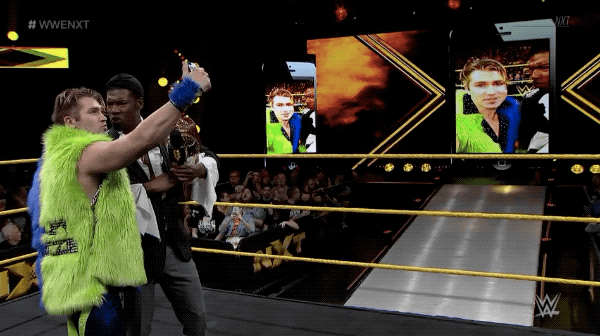
I guess what I’m trying to say is that seeing these two characters together was pretty cool.
Hey Dork, Make With The Wrestling Jokes Already, It’s Not Ibsen
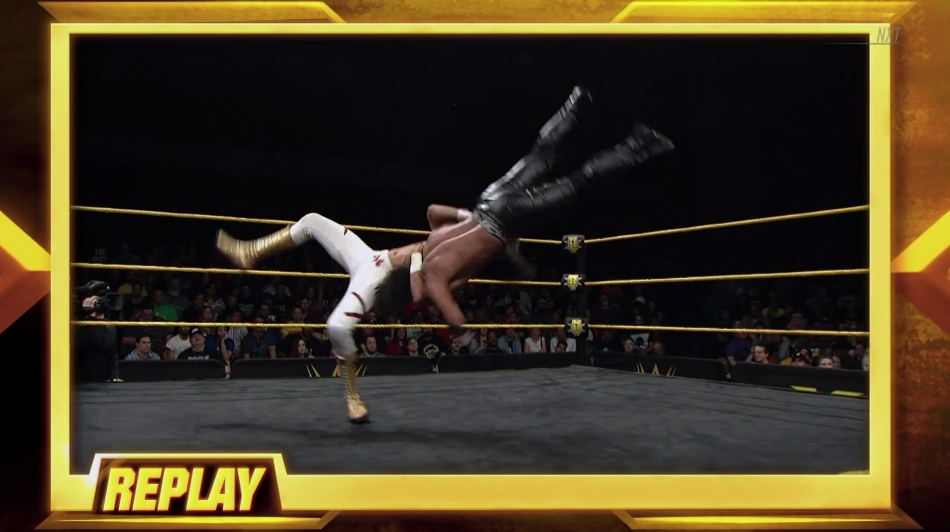
Oddly enough, my favorite match of the week was Mansoor vs. Sean Maluta. You know how I’m always talking about how everything on the show should have a reason to happen, even the positions of camera men backstage, because the conceit of the program is that we’re watching a real-live sporting event? It’s a sporting event presented like a soap opera, sure, but it’s supposed to be sports at its core. Sports it the point.
Anyway, what I’m trying to say is that I loved watching a one-on-one bout between lower ranked wrestlers. You can see top ranked stars like Adam Cole and Johnny Gargano on the big shows, or in the main events on weekly TV, but if a real company existed and really booked wrestling matches, they’d have an undercard, you know? Like in MMA, you’d get a bunch of fights that allowed younger or fresher talent to show what they’re made of and hopefully grow INTO top guys. Maybe they’d shine, maybe they wouldn’t, but if Sean Maluta and Mansoor keep coming to work and getting put in the ring against Dijakovic and Jaxson Ryker, wouldn’t they, you know, wrestle each other every now and then?
And that’s all it is. It’s two low-ranked guys jockeying for position at work. It’s where things like “momentum” might actually matter. If Mansoor can string together a few more victories like this, we’re going to think he’s got a better shot at beating a Dijakovic or a Ryker. He might not still, but you’ve done the work to bolster the believably of the entire project, and it benefits everyone.
Best: The Women’s Division Narrative Comes Together
Over the past several months (and arguably years), the grander story of the women’s division has been that it’s run by bullies. Little happy-go-lucky types can succeed moment to moment, but they can’t maintain it in the face of violence. Shayna Baszler and the Lesser Horses show up and break arms when they want, because they think it’s fun, and because fear is how Shayna remains in power. They’ve put the fear of God into Dakota Kai, broken Kairi Sane, physically put themselves back together to run Ember Moon out of town, and so on. It’s a long, storied history of winning because you’re bigger, stronger, and more.
Here, that’s directly illustrated in tiny-ass Candice LeRae squaring off against Reina Gonzalez, who doesn’t “emulate Stan Hansen” as much as look like Stan’s soul got tired of living in an old man’s body, spirited off to Texas, and possessed a local. Candice is fighting someone like three times her size, but her heart is the biggest thing in the world, so she wins with another weirdly edited Lionsault. Baslzer and her cronies show up and beat down Candice 3-on-1.
This is where the narrative comes together and gets turned on its ear, as Io Shirai shows up with a kendo stick and beats the ever loving shit out of everyone. Those of us who saw Shirai before NXT know what she’s about, but if you’ve only seen her in a WWE light, you might be excused for thinking she’s like Sane. Tiny and adorable and fun-loving, but good enough at pro wrestling that she can power up sometimes and win against the odds. That’s not Io Shirai. Io Shirai IS the odds. Now that Sane’s off being a kabuki warrior in the Great Unexplained, Shirai’s free to pursue her own goals, which apparently include maiming the people she’s sick of. The Horsies get lit the fuck up, and Shirai and LeRae share one of those uneasy alliances where you know they’re like five big fights from hoisting the black flag and slitting throats.
Best: Undisputed
You know what’s a great idea, just in general? Knowing that if you formed a faction or “stable” on your wrestling show, you should show why its forming was (and is) advantageous. Far too often groups like the League of Nations get together, and yeah, they do some 4-on-1 beatdowns, but they don’t really do anything. Them being friends is just a “number game” to WWE, it’s not for any purpose or reason.
The Undisputed Era is a brilliant idea, because while they make Adam Cole feel invincible — undisputed, even — they’re actually his downfall. Take the match in New York with Johnny Gargano for example. As both men have pointed out, Cole beat Gargano straight-up in the first fall. There was no cheating, no “opportunism,” no Cole even kinda playing dirty by working some injured body part. Cole just kicked Gargano’s ass and put him away. The problem is that while he’s wildly confident in himself to the point of narcissism, that kind of self love also comes with a secret loathing. Cole probably doesn’t even know HOW he beat Gargano straight up, because he’s so used to micromanaging his expectations and calling those cheating audibles. In the second fall of that match in New York, Cole starts getting frustrated and taking shortcuts. It costs him. That pushes him to an even more paranoid place, and in the third fall he’s so doubtful of his own abilities that he’s running plays with the full strength of the Undisputed Era. It costs him again, and costs him the championship.
Over the past several weeks, Cole’s been confronted with the concept of what life would be without his fully formed posse, and I think it helped him re-contextualize a few things. He can use them for pre-match attacks, like Roderick Strong did with Matt Riddle. He can guard himself with them. He can use them like assist trophies. But at the end of the day, Adam Cole (bay bay) is the power cell that makes the machine work. He’s the electricity.
Now tie those two things together. Cole is confident in his abilities again now without being brave enough to truly disconnect from his big shortcut, but he knows his ability to manipulate and control people is what brought him to the dance. With an announced rematch coming up, we’ve got a refocused Cole that not only understands his weaknesses, but revels in them. It’s one fall to a finish, and all he needs to do to beat Gargano is to hit him with every bomb in the arsenal, all at once. He can turn three falls into one, which should be a piece of cake, right?
Here’s what Gargano knows, though, after two years of dealing with Tommaso Ciampa: Cole still doesn’t understand that his meticulous planning is still in absence of a true confidence, and no amount of referee distraction can replace your self-worth.
Next Week:
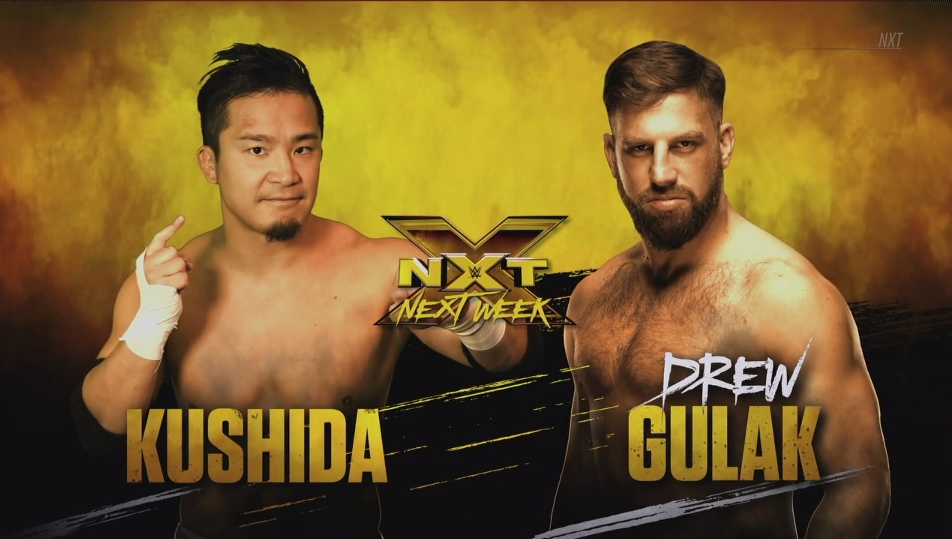
- KUSHIDA faces his first good opponent, Drew Gulak
- Bianca Belair and Mia Yim continue their gum-popping snaps battles inside the ring
- more tag team action as we build to the ladder match at TakeOver 25
- a lengthy essay on how NXT TV will remain consistent for the next ten years, and what the Bobby Fish character will be doing in NXT in 2029
Most of this and more, next week!

